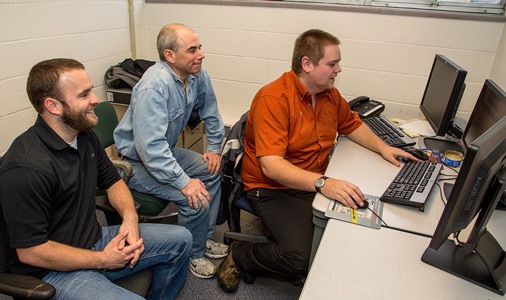Students turn equations into sports schedules

Scheduling sports seasons can be a daunting task for athletic conferences. It involves plenty of math: starting with a finite number of teams, adding home and away games and bye requirements, subtracting black-out dates and multiplying by transportation restrictions.
Fortunately, mathematics students at the University of Wisconsin-Stevens Point have an equation to solve that problem. Actually, they have thousands of equations.
Created in 2006, the Center for Athletic Scheduling at UW-Stevens Point employs students who use mathematical techniques to create individual sports schedules for collegiate athletic teams. It’s the only such program in the world to use undergraduate students – five programmers and one office manager.
Wisconsin Intercollegiate Athletic Conference (WIAC) Commissioner Gary Karner or team coaches used to develop schedules by hand. It was a long, arduous process that, if done by coaches, wasn’t seen as neutral for their teams.
When Mathematics Professor Andy Felt asked Karner to meet with students in his Math 315 course to create a better WIAC basketball schedule, Karner joked that they should take on something easier, like global warming. Two weeks later, the class had created a mathematical model that reflected the properties needed in the WIAC schedule. The first official WIAC schedule was created in 2008.
“Having this service lifted an incredible burden off a conference like ours,” said Karner. “Having that neutrality is significant. What they are accomplishing is simply remarkable, so I’m their biggest cheerleader.”
The center now provides for 80 percent of the schedules for the WIAC and also works with clients across the nation, such as the Presidents’ Athletic Conference, Southern California Intercollegiate Athletic Conference and the Middle Atlantic, Freedom and Commonwealth conferences.
Each sport’s schedule is different, so no single model can be used, said Felt. The students, chosen by Felt from one of his advanced courses, create each schedule individually using equations for each variable. The variables include each team and every scheduling constraint. Take, for example, travel restrictions. In basketball, teams cannot have more than two away games in a row. Pointer men and women travel together on weekdays; on weekends, either the men or women play at home. Add to the mix bye game specifications, multiple divisions and the number of home and away games.
This model is called mixed integer linear programming. It provides the optimal athletic schedule by defining when each team can meet another within those constraints. A computer modeling language assists the programmers.
“It’s a glorious thing when it works,” said Craig Beer, a senior mathematics major from Stevens Point. “If it doesn’t work, we can tell them in no uncertain terms that it’s mathematically impossible.”
Challenges can arise as programmers and athletic commissioners learn each other’s lingo and expectations. Communication is often a bigger challenge than the programming, Beer said. Each model may go through several drafts before a full schedule can be created that meets the requested constraints.
The students develop skills not taught in a classroom, Felt said. “They have to learn how to explain the project to those who may not understand math but have to use it.”
“I’ll most definitely use the skills I’ve learned here in the future,” said Beer, “especially the problem solving and thinking skills it takes to find the small details that make the models work.”
Working at the center has been a great experience for mathematics major Tyler Peters of Wisconsin Rapids. “It’s an opportunity I never saw coming. I’m very thankful for it. I would love to do something like it for a living.”
One of the center’s recent graduates is doing just that. He created his own sports scheduling business aimed at Division I and II clientele, while the center at UW-Stevens Point plans to stay with its Division III clients.
With an average revenue of $3,000 a year, the center provides for student salaries, funding for attending conferences and student scholarships. UW-Stevens Point helps with much of the overhead, including office space and equipment.
Felt’s purpose is more altruistic than profit or size. “It’s accomplishing the goal I set originally,” he said, “which was to give students real world experiences and accomplish cool things out of the classroom.”
